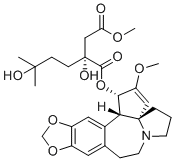Harringtonine is a natural Cephalotaxus alkaloid found in Cephalotaxuts. It immobilizes initiated ribtosomes, inhibiting protein translation by blocking the ribosomal A site. It suppresses viral replication and protein expression in chikungunya virus infection, inhibits cell growth in actue promyelocytic leukemia cells, and induces apoptosis in leukemia cells.
Physicochemical Properties
| Molecular Formula | C28H37NO9 |
| Molecular Weight | 531.5947 |
| Exact Mass | 531.246 |
| Elemental Analysis | C, 63.26; H, 7.02; N, 2.63; O, 27.09 |
| CAS # | 26833-85-2 |
| PubChem CID | 276389 |
| Appearance | White to light yellow solid powder |
| Density | 1.4±0.1 g/cm3 |
| Boiling Point | 679.4±55.0 °C at 760 mmHg |
| Melting Point | 73-75ºC |
| Flash Point | 364.7±31.5 °C |
| Vapour Pressure | 0.0±2.2 mmHg at 25°C |
| Index of Refraction | 1.610 |
| LogP | 2.58 |
| Hydrogen Bond Donor Count | 2 |
| Hydrogen Bond Acceptor Count | 10 |
| Rotatable Bond Count | 10 |
| Heavy Atom Count | 38 |
| Complexity | 953 |
| Defined Atom Stereocenter Count | 4 |
| SMILES | O(C([C@@](C([H])([H])C(=O)OC([H])([H])[H])(C([H])([H])C([H])([H])C(C([H])([H])[H])(C([H])([H])[H])O[H])O[H])=O)[C@]1([H])C(=C([H])[C@]23C([H])([H])C([H])([H])C([H])([H])N2C([H])([H])C([H])([H])C2=C([H])C4=C(C([H])=C2[C@]31[H])OC([H])([H])O4)OC([H])([H])[H] |
| InChi Key | HAVJATCHLFRDHY-KSZYUSJVSA-N |
| InChi Code | InChI=1S/C28H37NO9/c1-26(2,32)8-9-28(33,15-22(30)35-4)25(31)38-24-21(34-3)14-27-7-5-10-29(27)11-6-17-12-19-20(37-16-36-19)13-18(17)23(24)27/h12-14,23-24,32-33H,5-11,15-16H2,1-4H3/t23-,24-,27+,28-/m1/s1 |
| Chemical Name | 1-((1S,3aR,14bS)-2-methoxy-1,5,6,8,9,14b-hexahydro-4H-[1,3]dioxolo[4',5' |
| Synonyms | 2'R-Harringtonine; Harringtonine; Alkaloid C from cephalotaxus; NSC 124147; NSC-124147; NSC124147. |
| HS Tariff Code | 2934.99.9001 |
| Storage |
Powder-20°C 3 years 4°C 2 years In solvent -80°C 6 months -20°C 1 month |
| Shipping Condition | Room temperature (This product is stable at ambient temperature for a few days during ordinary shipping and time spent in Customs) |
Biological Activity
| ln Vitro | By blocking substrate binding to the acceptor site on the 60-S ribosome subunit, harringtonine inhibits the elongation phase of translation by preventing aminoacyl-tRNA binding and the formation of peptide bonds[1]. With an EC50 of 0.24 μM, harringtonine exhibits strong inhibition of Chikungunya virus infection. Other alphaviruses may be inhibited by harringtonine[2]. At low concentrations, haltrine inhibits the growth of human myeloid leukemia cells in vitro. The breakdown of polysomes into monosomes is thought to be the hallmark of harringtonine's antitumor action mechanism, which is thought to be based on an impact on protein synthesis[3]. |
| References |
[1]. Inhibition of translation in eukaryotic systems by harringtonine. Eur J Biochem. 1977 Jan;72(2):323-30. [2]. Inhibition of chikungunya virus replication by harringtonine, a novel antiviral that suppresses viral protein expression. Antimicrob Agents Chemother. 2013 Jan;57(1):155-67. [3]. Growth inhibition of human myeloid leukemia cells in vitro by harringtonine. Gan To Kagaku Ryoho. 1990 Feb;17(2):281-5. |
| Additional Infomation |
Harringtonine is an alkaloid. Harringtonine has been reported in Cephalotaxus fortunei, Apis cerana, and Cephalotaxus harringtonia with data available. |
Solubility Data
| Solubility (In Vitro) |
DMSO : ~100 mg/mL ( ~188.11 mM ) Ethanol : ~100 mg/mL |
| Solubility (In Vivo) |
Solubility in Formulation 1: ≥ 2.5 mg/mL (4.70 mM) (saturation unknown) in 10% DMSO + 40% PEG300 + 5% Tween80 + 45% Saline (add these co-solvents sequentially from left to right, and one by one), clear solution. For example, if 1 mL of working solution is to be prepared, you can add 100 μL of 25.0 mg/mL clear DMSO stock solution to 400 μL PEG300 and mix evenly; then add 50 μL Tween-80 to the above solution and mix evenly; then add 450 μL normal saline to adjust the volume to 1 mL. Preparation of saline: Dissolve 0.9 g of sodium chloride in 100 mL ddH₂ O to obtain a clear solution. Solubility in Formulation 2: ≥ 2.5 mg/mL (4.70 mM) (saturation unknown) in 10% DMSO + 90% (20% SBE-β-CD in Saline) (add these co-solvents sequentially from left to right, and one by one), clear solution. For example, if 1 mL of working solution is to be prepared, you can add 100 μL of 25.0 mg/mL clear DMSO stock solution to 900 μL of 20% SBE-β-CD physiological saline solution and mix evenly. Preparation of 20% SBE-β-CD in Saline (4°C,1 week): Dissolve 2 g SBE-β-CD in 10 mL saline to obtain a clear solution. Solubility in Formulation 3: ≥ 2.5 mg/mL (4.70 mM) (saturation unknown) in 10% DMSO + 90% Corn Oil (add these co-solvents sequentially from left to right, and one by one), clear solution. For example, if 1 mL of working solution is to be prepared, you can add 100 μL of 25.0 mg/mL clear DMSO stock solution to 900 μL of corn oil and mix evenly. Solubility in Formulation 4: 10% DMSO+40% PEG300+5% Tween-80+45% Saline: ≥ 2.5 mg/mL (4.70 mM) (Please use freshly prepared in vivo formulations for optimal results.) |
| Preparing Stock Solutions | 1 mg | 5 mg | 10 mg | |
| 1 mM | 1.8811 mL | 9.4057 mL | 18.8115 mL | |
| 5 mM | 0.3762 mL | 1.8811 mL | 3.7623 mL | |
| 10 mM | 0.1881 mL | 0.9406 mL | 1.8811 mL |
